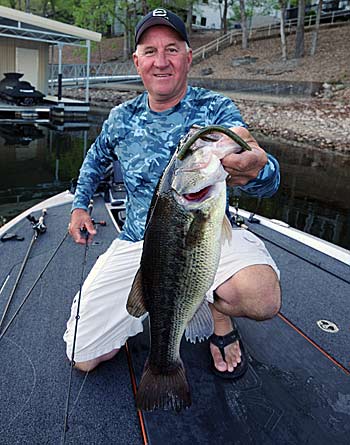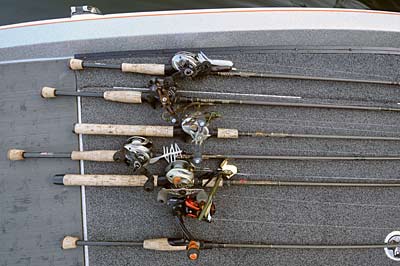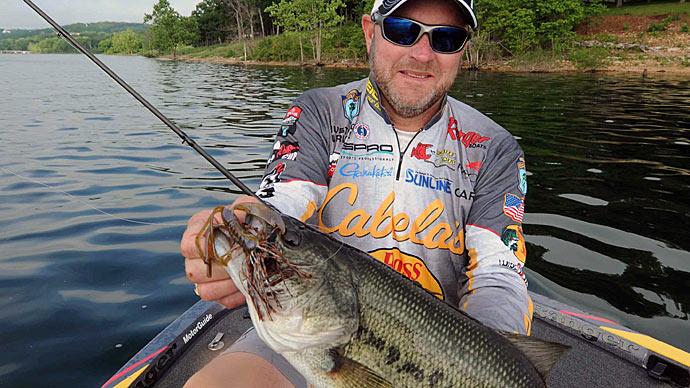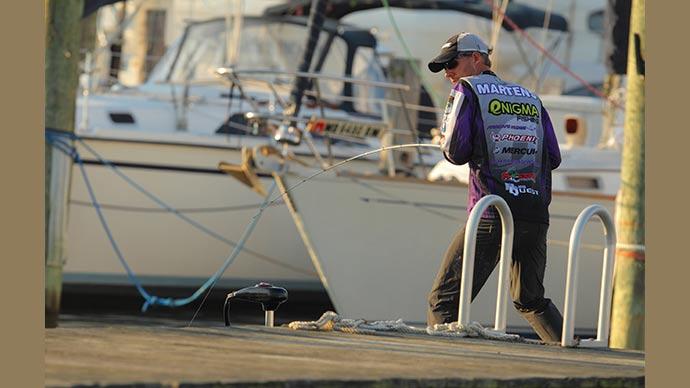
When the bass spawn is on, shiny spots dot the shallows of a lake.
The shiny spots become critical targets for presenting lures to spawning bass. When selecting lures for the spawn, Missouri guide Jim Dill tries to determine whether bass are circling in and out of their nests (shiny spots) or locked on their spawning beds. "Finding bass in different stages dictates what kind of bait you are going to throw at them," Dill says.
Dill's lure selection also depends on whether the spawning bass have made their beds along open banks or close to cover, such as the back end of boat docks, log laydowns, boulders, or flooded bushes. "The bass—particularly big ones—are conditioned not to spawn necessarily out in the open," Dill says. "They like something over their head or something with a little backdrop, so they only have to protect half of their bed and not all the way around it."
The regional tournament competitor and Lake of the Ozarks guide usually starts fishing with a topwater lure such as a buzz bait to see if the fish “will show themselves” by hitting or missing the surface bait. If a bass swirls and misses the buzz bait, Dill follows up with a slow-falling stickworm that can be suspended for a while above the spot where the fish missed his buzzer. If a bass ignores this offering, Dill switches to a bottom bait he can drag through and around the nest.
Here is a look at Dill's six lures to catch bass during the spawn.
Buzz Bait
“The buzz bait is for fishing bigger rocks and steeper banks you can run down for bass that are just moving in," says Dill. The lure is also a good locator for finding bedding bass in dirty water. The buzzer allows Dill to cover a lot of water in the shallows and make multiple presentations to a spot where he thinks a nest might be.
Lure size: 3/4-ounce Crock-O-Gator Head Knocker. “It’s a heavier bait that I can throw farther, and I can creep it really slow because it has a big blade that will plane out so I can slow it down and antagonize the fish to come up and hit it," Dill says.
Colors: A black skirt with a gold blade.
Presentation: “I like to keep the buzz bait close to or around the bed as long as possible," Dill says. “If it is moving fast and they don't see it as a threat, they won't bother it. But if it is moving slowly on top of their bed, they tend to get aggravated quicker and come up on it."
Tackle: 7-foot-2-inch heavy action casting rod, 7.5:1 gear ratio baitcast reel, 50-pound braid line.
Jig
“The jig is a natural-looking bait that will lie in or around the bed,” Dill says. “It is a bait you can sit in the nest and eventually the fish will pick it up to move it.” The guide also likes to hop the jig around the outside of the nest to catch aggressive bass.
Size: 3/8-ounce Crock-O-Gator Zapper Jig and a Crock-O-Gator Ring Craw.
Colors: Green pumpkin with orange, red, or chartreuse flake Zapper Jig and green pumpkin or white Ring Craw
Presentation: “I throw the jig up to where I think there is a bed, hop it into the bed, and then bounce or shake it within the middle and outside ring of the bed, trying to figure out where the sweet spot of the bed is,” Dill says. “Once I figure that out, I can leave the jig close to that spot to get the bass to respond.”
Tackle: 7-foot medium-heavy action casting rod, Team Lew’s Hypermag 8.3:1 or Bass Pro Shops Pro Qualifier 7.5:1 baitcast reel, 15-pound fluorocarbon.
Wacky-Rigged Stickworm
“(The stickworm) is another real slow-moving and subtle bait that you can throw past the bed or around the bed," Dill says. “It is one of the best bed fishing baits with an exposed hook. It has a lot of action without moving it out of their strike zone, so it remains a threat and gets the bass’ attention.”
Size: 5-inch Yamamoto Senko or Bass Pro Shops Stik-O impaled wacky style (hook in the middle of the lure) on a number 1 Owner circle hook.
Colors: Green pumpkin/red flake or white.
Presentation: “I twitch it up to the bed and let it sink really, really slow and then give it a little twitch,” Dill says. “It just looks like a small snake or big nightcrawler.”
Tackle: 7-foot medium action Falcon spinning rod, Lew’s 2000 spool spinning reel, 20-pound high-vis yellow braid main line and 12-pound fluorocarbon leader.
Creature Bait

The Crock-o-Gator Swamp Bug, with its lively tentacles, is Dill's choice for sitting in a bass bed. “It has a lot of action and looks like something alive,” he says.
Size: Small Swamp Bug on a 1/4-ounce standup football jighead.
Color: White.
Presentation: “I hop it an inch off the bottom and let it come back down," Dill says. "The tail and legs move so I can just quiver and shake it, and the fish can't stand it."
Tackle: 7-foot medium-heavy casting rod, Team Lew’s Hypermag 8.3:1 baitcast reel, 12- or 15-pound fluorocarbon line.
Carolina-Rigged Lizard or Creature Bait
Dill prefers the Carolina rig for dragging his lure through nests for bass spawning in deeper water.
Size: 6-inch Zoom plastic lizard on a 3/0 or 4/0 wide gap hook; Swamp Bug Sr. and 6-inch Zoom Brush Hog on a 5/0 wide gap hook; Reaction Innovations Sweet Beaver or Missile Baits D-Bomb on 4/0 wide gap hook; 3/4-ounce brass bullet weight; one or two glass beads and a swivel.
Colors: Green pumpkin with chartreuse dye on the tail.
Presentation: "I just throw it past where I think a bed is and use a steady (dragging) retrieve, and as that bait comes to the bed, the bass will usually hit the bait, pick it up, and move it off,” Dill says.
Tackle: 7-02 or 7-04 medium-heavy casting rod, 7.5:1 or 8.3:1 baitcast reel, 17-pound fluorocarbon main line and 12-pound low-vis green monofilament.
Tube Bait
Dill considers the flipping tube another creature-type bait with a lot of tentacles to tantalize bass on nests. “If a bass is spooky when I throw the tube up to the nest and the fish takes off, I can just leave it lie there.” He suggests that the tube looks like a natural predator that a bass will attack as the lure sits in the nest.
Size: 4-inch flipping tube on a 3/0 or 4/0 wide gap hook and a 1/4-ounce bullet weight.
Colors: Black neon, chartreuse/purple or pearl.
Presentation: Dill leaves his worm weight unpegged so the tube will fall freely with a spiraling, erratic descent. "I can hop it and twitch it real quick, and that tube has just crazy action,” he says.
Tackle: 7-foot medium action casting rod, Team Lew’s Hypermag 8.3:1 baitcast reel, 12- or 15-pound test fluorocarbon.
BassResource may receive a portion of revenues if you make a purchase using a link above.




